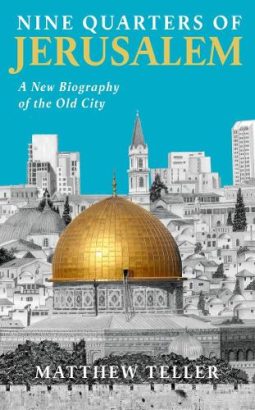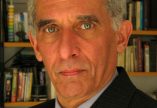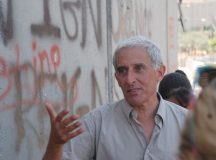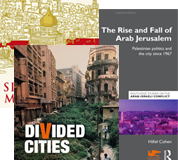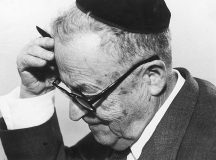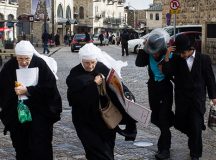There are no experts on Jerusalem. The city is too complex, its history too long, too shrouded in the mists of time, and its conquerors almost too numerous to count. It’s a city that thrives on its contradictions. There are indeed great scholars who have genuine expertise on parts of the city, some of its communities or slices of its history. There are also fine generalists who sacrifice some nuance and accuracy in order to capture something of the breadth and depth of the city. But often the purported ‘experts’ are those who peddle a mythical Jerusalem to advance their sundry ulterior motives, and whose Jerusalem is unrecognisable to anyone familiar with the city. It is the latter who dominate much of the contemporary discourse on Jerusalem.
Nothing of this prevents us Jerusalem aficionados and buffs (such as myself) from assuming the trappings and percs of scholarly experts. We bicker amongst ourselves about epoch-making events and minutiae, over which Ekramawi hummus joint is best (there are at least three), as well as the historicity of Biblical characters and events. We especially delight in ‘gotcha moments’ when we catch a fellow Jerusalem ‘expert’ in a grievous error. And we generally treat authors, tour guides, journalists and filmmakers who purport to describe the city with condescension, if not contempt.
Consequently, I approached Matthew Teller’s The Nine Quarters of Jerusalem with a cavalier attitude of ‘OK, let’s see what you got, outsider’, accompanied with schadenfreude poised to pounce
I could not have been more mistaken.
The Nine Quarters of Jerusalem deals with a part of Jerusalem I know well: its historical, geographical, spiritual and social core, the Old City, And Matthew Teller creates a faithful portrait of that city. It is a feat that I did not think achievable by someone who does not live here. Instead of gloating over the book’s anticipated errors, I found myself conversing with the text. ‘Hey, I also said that’; ‘why DIDN’T I say that – I should have’; ‘why did you leave this point out’ (at times discovering three pages later that it wasn’t left out at all); ‘how dare you say that!?’. The reading experience was akin to an intense, often bantering conversation with an old friend, but one whom I had never actually met.
The book describes itself as ‘a new biography of the Old City’. It’s a pithy description, but does not do justice to the book. Overall, The Nine Quarters is a collection of portraits of the numerous organic communities that make up the mosaic of the contemporary Old City. And it is structured as a framed collage.
The book commences by illuminating the framework for what is to follow. The author rather mercilessly debunks the popular image of an Old City neatly divided geographically and otherwise into four distinct quarters: the Armenian, Muslim, Christian and Jewish Quarters. Teller compellingly demonstrates that this is an artificial construct, born largely of colonialism and perpetuated by sundry interested parties. It also has little or no correlation to the real Old City and its various communities. Much of the rest of the book is devoted to demonstrating just how much the real people, communities, faiths and patterns of life blatantly defy the popular image of a Jerusalem divided into four quarters.
The issue of the Old City’s four quarters also has some very timely and very controversial implications. In December 2021, the Heads of Churches in Jerusalem released a cri de coeur regarding the plight of the Christian community in Jerusalem. It included a rather cryptic sentence: ‘The principle that the spiritual and cultural character of Jerusalem’s distinct and historic quarters should be protected is already recognised in Israeli law with respect to the Jewish Quarter. Yet radical groups continue to acquire strategic property in the Christian Quarter, with the aim of diminishing the Christian presence’. This laconic statement, explicitly referring to ‘the four quarters of Jerusalem’, points to one of the most incendiary issues in Jerusalem today: the fate of two Church-owned hotels at Jaffa Gate that are being taken over by settlers.
In 1978, the Israeli Supreme Court ruled that Palestinians are forbidden from purchasing properties in the Jewish Quarter of the Old City. The prohibition also applies to Palestinians who has owned property and lived in the Jewish Quarter prior to 1948. In so ruling, Justice Shamgar (later Chief Justice) invoked the image of a Jerusalem divided into four quarters – a division that Teller compellingly demonstrates never really existed. ‘There is evidence to the effect that since the 11th Century, residence in the Old City has been divided by community, each community with its own quarter’. Consequently, he ruled, the historical character of Jerusalem mandates that the Jewish Quarter be reserved for Jews. However, as the Heads of Churches imply, it’s not that simple. If that be the case, why has the Government of Israel supported Jewish settlement in the Muslim and Christian Quarters? If only Jews are allowed to live in the Jewish Quarter, why is the government of Israel not only allowing but supporting settlers in taking over properties in the Muslim and Christian quarters – most recently at Jaffa Gate.
The heads of Churches are sending a clear message to the Government of Israel, and putting a gun on the table. While the Israeli Government has determined that the Jewish Quarter is exclusively for Jews, that same Government supports and encourages Israeli settlers to take over properties in the Christians and Muslim Quarters.
Teller alludes to these issues without explicitly describing the current dispute. In doing so, the author treads through one of the dangerous minefields that exists for any who write about contemporary Jerusalem: the geopolitics of the city. Jerusalem in general, and the Old City in particular, are among the most politically controversial in the world. If you ignore the realities of Israeli rule – occupation – you become a hasbarista purveying Israel’s rather hollow PR; if, as many have done, one focuses entirely on occupation, the writing becomes a two-dimensional manifesto. The author deftly finds the middle ground. Like those he interviews, he does not ignore the pervasive impact of Israeli rule – occupation – but neither does he or his protagonists allow that occupation to consume them or to exhaust who they and their communities are. ‘True believers’ in an eternal, undivided Jerusalem will find this book objectionable; however, many of who disagree with the author’s views will find this to be a book informed, but not driven by politics, and well worth reading. He threads the needle well.
The author allows the members of the various communities in the Old City (even the most neglected ones) to speak for themselves, and, at times, allows the walls and gates to ‘tell’ their own story. And both of these are told by a rapporteur with a keen eye and mastery of language that is incisive and impish simultaneously. The result is a composite of miniature portraits of the mosaic of the Old City, more oil-painting than photograph. The stories told are riveting, and in spite of my own familiarity with the sites and some of these communities, I learned much.
The manner in which the author deals with the Jewish quarter and the Jewish presence in the Old City throughout the ages is likely the most controversial part of the book, and has already generated some heated polemics. The author makes no bones about it:
‘… [T]his book rejects equality in favour of equity. Rather than setting stories that are Jewish against an equal number of stories that are from or about everybody else, I have instead redistributed my time, energy and resources to favour those who begin less advantaged. Rather than amplifying the already-amplified, I have chosen to amplify the unlistened-to.’
One may question the author’s judgment in exercising this editorial ‘affirmative action’, but cannot fault his candour.
However, the rather lean description of the Jewish Quarter of the Old City derives from something much larger than this editorial judgment call, and which was for me the most important – and disturbing – take-away from this book. The Jewish Quarter does not assume its place among the organic communities of the Old City because it has no business being there. The already fragile Jewish presence in the Old City was shattered by the destruction of the Jewish Quarter and the imprisonment of its residents in 1948. Israel’s efforts to restore that community have failed, in what was a likely pre-ordained failure. The Jewish Quarter is located in the Old City. An organic part of it? No.
All of Jerusalem’s communities throughout history have experienced challenges to their existence that have been caused by conquest, famine, and the rise and fall of faiths and empires. In that sense, the Jews of the Old City were no different, often hanging on by their fingernails to maintain their community against overwhelming odds. However, the blows dealt to the Jewish community by the destruction of the Temple and by the expulsion from the Old City two millennia later are unique in both magnitude and impact.
Already in the late 19th century, the indigenous Jewish inhabitants of the Old City and the Jewish quarter – the largely ultra-Orthodox ‘Old Yishuv’ – began an exodus to the new city. The trend was accelerated as a result of the Palestinian uprisings in 1929 and 1936, when the Jews who had lived for many years in the Muslim Quarter moved out, finding refuge elsewhere. The deathblow came in 1948, when many of the residents of the Jewish Quarter fled or were evacuated, others taken prisoner by the Jordanian legion, and part of the Quarter demolished.
After the war in 1967, none of the Jewish Quarter’s pre-1948 population returned. The Old Yishuv died in 1948, along with the roots that had been deeply implanted in the city‘s past. The gallery of individuals who returned to the Jewish Quarter after the war, a fascinating group indeed, had no personal roots there. Most of these residents are long gone, not finding their places within a gentrified fortress populated largely by the sons and daughters of wealthy ultra-Orthodox diaspora Jews and transient tenants who rent from them. The architecture is a crass, post-modern rendition of an upscale Jewish Quarter, which today is laced with more building violations than anywhere else in Israel.
A new Jewish community rooted and part of the Old City may over time emerge from the current Jewish Quarter. There is no indication that such a trend has commenced. I frequent the Old City often because I discover new things on every visit, and delight in revisiting past discoveries. I rarely visit the Jewish Quarter – there is simply not much to see there.
The Epilogue of the book is a disappointment. The reverence and understatement with which the author approached his subjects in the Old City is cast aside, to be replaced by a very ambitious discussion of the conflict between Israelis and Palestinians. We are taken well beyond the geographical boundaries of the book – the Old City – and well beyond the thematic boundaries the author created in his portrait of its communities and landmarks. The Epilogue could well be a stand-alone opinion piece in a respected journal, or even better, a chapter in a new and very different book by the author. As is, it deviates from the stylistic and substantive coherence of the rest of the book.
That said, Nine Quarters of Jerusalem is a gem, highly informative, and a delight to read. It will make contemporary Jerusalem – the real one, and not the hollow and fictitious one purveyed by sundry ‘Jerusalem-mongers’ – accessible to those unfamiliar with the city. It will also enrich and edify those who know the city well.

